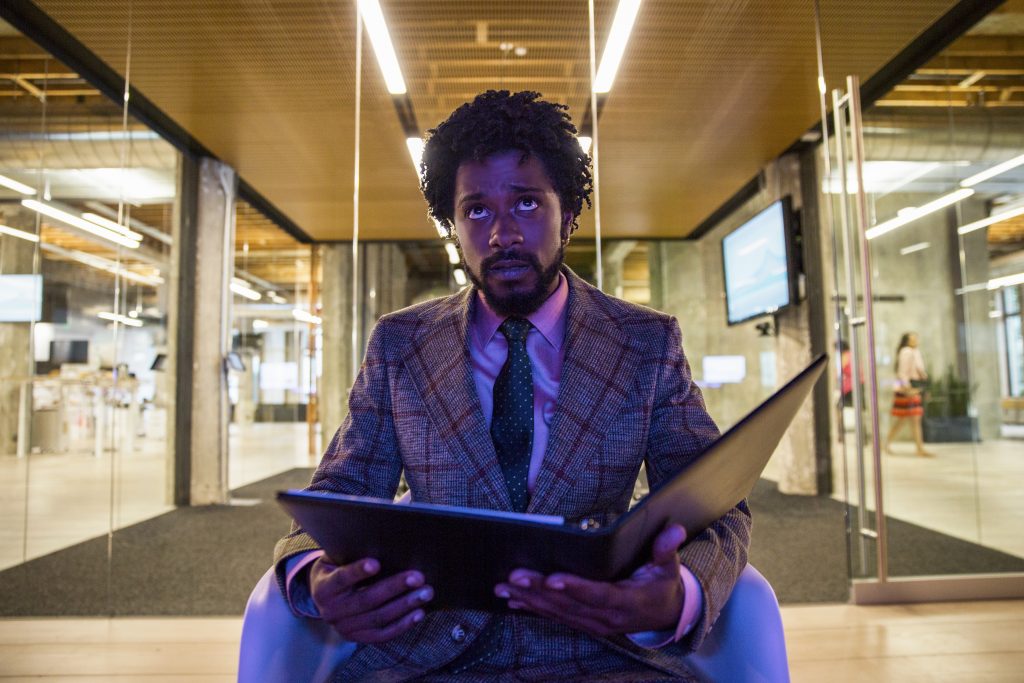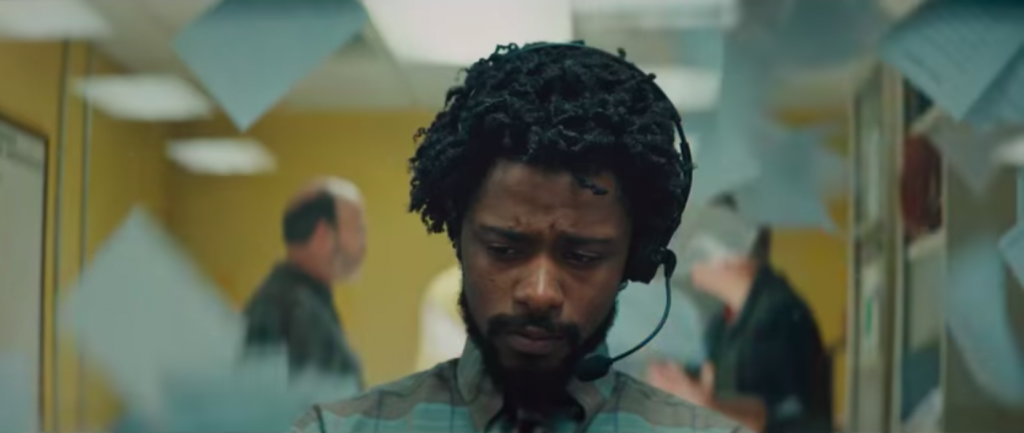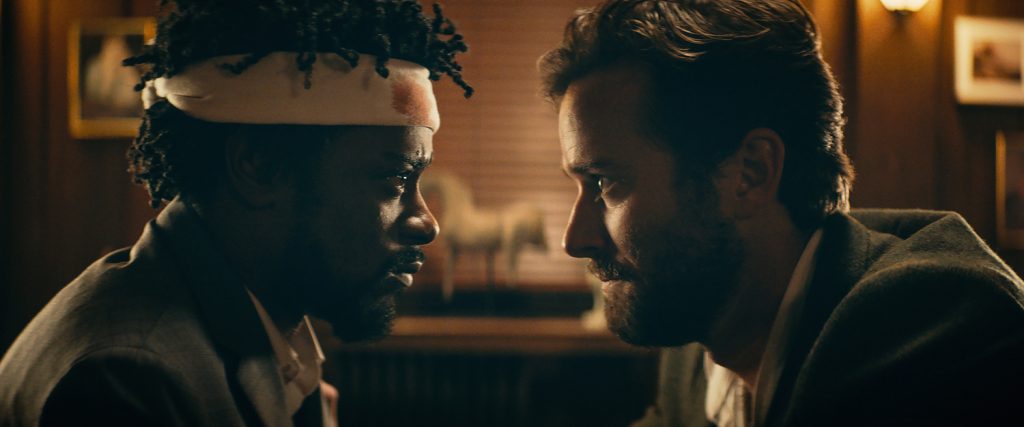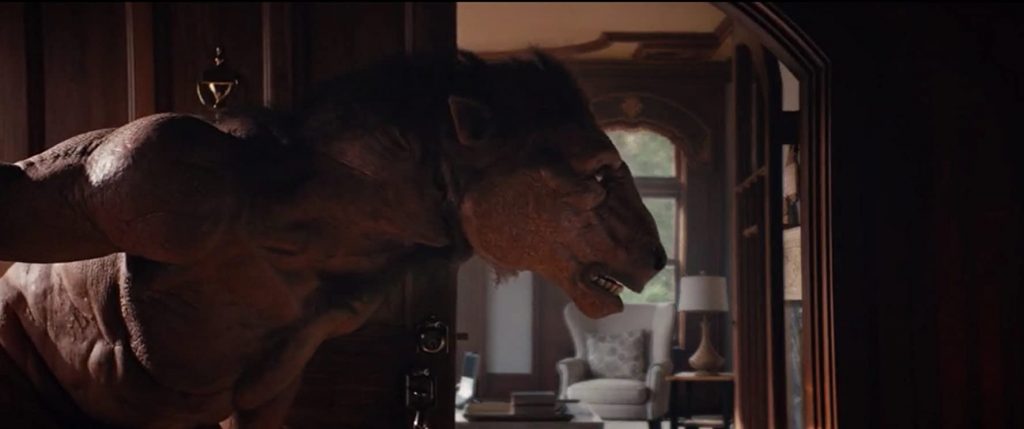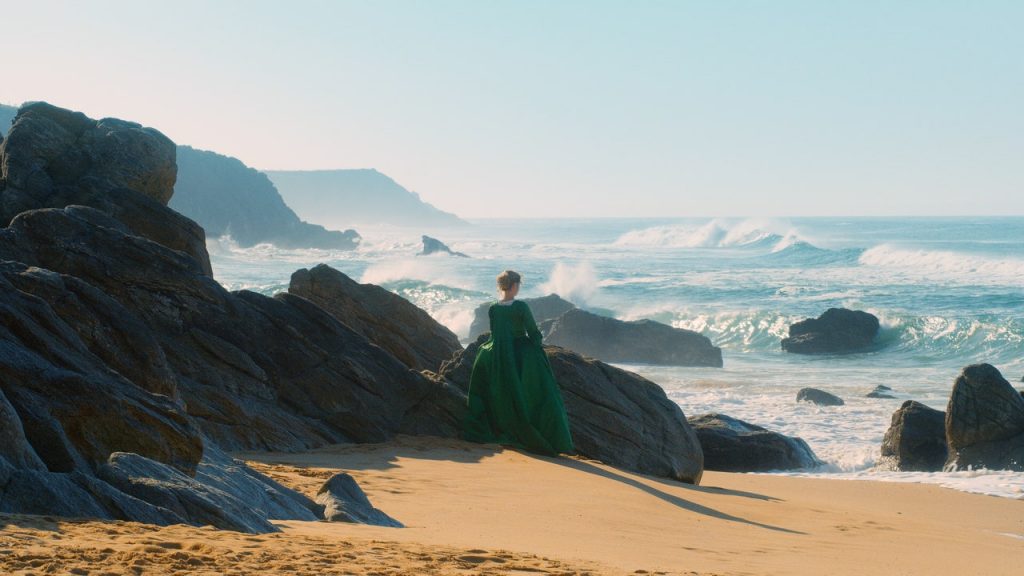
by Vanessa X. Sun
Deeply mesmerizing and arresting all at once, Portrait of a Lady on Fire, directed by Céline Sciamma, is a powerful film of queer love, the female gaze, and ultimately the representation of women and how they live together. Throughout the film, there are a number of impactful cinematic scenes that may be viewed as, quite fittingly, portraits with intense depth and meaning in their own right. How are we to fully appreciate these powerful, key scenes in the film, and understand what they imply? This essay highlights these key scenes by detailing the color and lighting techniques Sciamma uses to build layers of hidden meaning. These layered symbols and images reveal to the audience the true reality of the film’s two lead characters, Héloïse (Adèle Haenel) and Marianne (Noémie Merlant).
The first key scene I discuss occurs near the end of the story, when Héloïse’s dress catches on fire at the bonfire that she attends with Marianne and Sophie. In this scene, as Héloïse’s blue dress burns, she stares across the field at Marianne as music swells around them and abruptly fades. The scene is the subject of the portrait that we see in the first few minutes of the film. We realize that the blue dress holds a world of meaning, as it symbolizes Héloïse’s despair about being married to a man she’s never met, and how oppressive the world is for women and their freedom. The burning of the dress also appears to be a physical manifestation of the relationship between Marianne and Héloïse; as the flame appears to destroy the oppressiveness that the blue color represents, it allows Marianne and Héloïse to finally take a step into their relationship with each other. How does the viewer come to be able to fully appreciate all of the rich meaning in the portrait-like key scene?
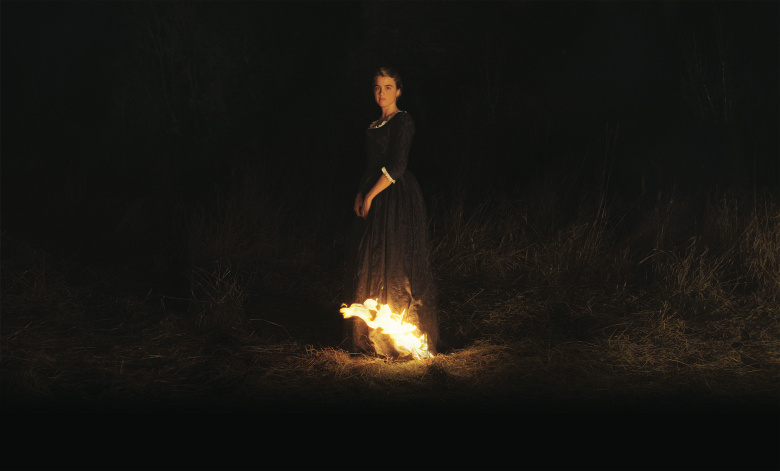
At the beginning of the film, Marianne is seen to be in an art studio, in which she sits at the front of the room in a blue dress, instructing her art students to observe her closely as they render her portrait on their canvases. Marianne’s blue dress, which the viewer initially may not take to be significant, is clearly an intentional choice by the Sciamma and the costume designers, one that indicates the oppressive, melancholic nature of Marianne’s world. The fact that the beginning scene in which Marianne is wearing the blue dress is set in the present, while the rest of the film in set in the past, indicates that the chains of society and the patriarchy remain undefeated – she is, put succinctly, blue. This hopelessness manifests in Marianne, and hints that the story we see unfold later on will not be an exultant one.

Additionally, when Héloïse and Marianne first take a walk on the beach, the ocean often surrounds them in the frame of the camera, with its vibrant blue color cool in hue and highly saturated, giving it a constant presence throughout the many walks the women take together. Ordinarily, a viewer might have seen the ocean and not think too much about it, but through the dress-on-fire key scene, the viewer realizes that there is so much more to the ocean and its color than may be obvious. In fact, the unique vibrance of the blue ocean and its far reaches serves to further symbolize the reach of the burdens that women had to bear during those times and how they could not run from it. No matter where Héloïse and Marianne walk, the ocean follows, giving the blue color a slightly ominous presence. Even when Marianne gets back from her walks on the beach, Marianne cannot escape the blue, as her rooms are painted a light shade of blue, an implication that societal repressiveness is all around the women, even in private spaces. Any time Heloise stands in the room in her blue dress, there is a corporeal match in which Héloïse’s clothes match the color of the walls, which further serves to reinforce the fact that oppressive societal restraints envelop these women.
When Marianne comes to stay at the house, the house is encased in utter darkness, save the flame that lights Marianne’s way. Even Marianne’s rooms are dark, saved from complete indiscernibility by the fire that crackles in the room. The viewer comes to realize the fire not only lights Marianne’s way out of the dark literally, but also figuratively leads her out of the darkness of society’s hold as she starts to embrace her feelings and emotions towards Héloïse. The play on the value, hue, and saturation of blue throughout the scenes leading up to the key dress-burning scene greatly allows the viewer to appreciate this key scene more deeply. The manipulation of light and darkness with fire helps to steer the viewer to understand more deeply the symbolic meaning behind Sciamma’s technique. To fully comment on the harsh situation in which these women find themselves and the suffocation of the expectations towards the women of the times, Portrait chooses not to spell everything out for the viewer. Instead, layers of meaning build up through different scenes in order to imbue the film with a world of meaning and depth, allowing the viewer to fully appreciate the powerful intersection of symbolism and social realities.
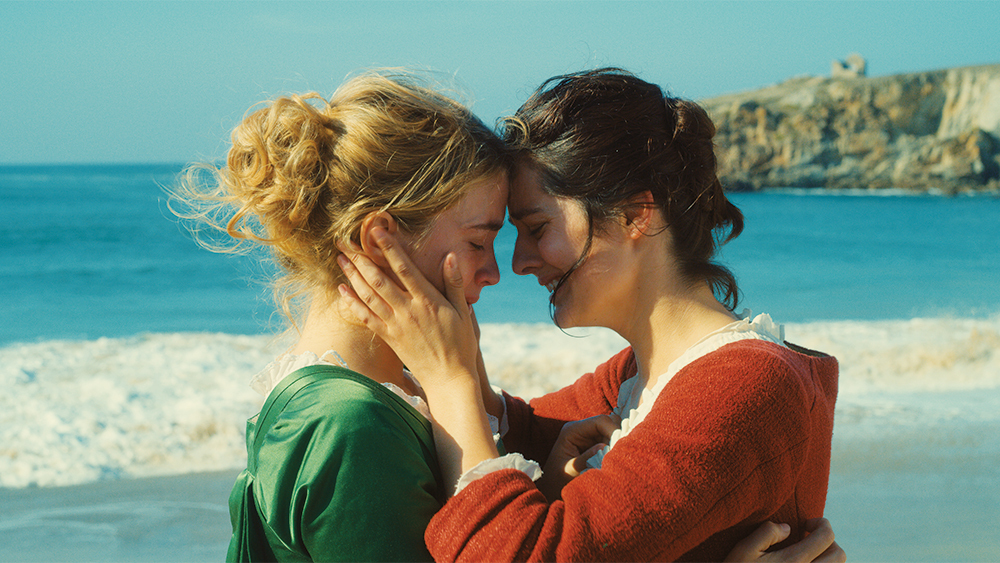
The second key scene I examine occurs when Marianne rushes to apologize to Héloïse after an argument at the house. In this scene, Marianne stands in a warm-hued, semi-saturated red dress, embracing Héloïse, who is standing in a bright green dress, as the vibrant blue ocean surrounds them in the background. On the surface, this scene is important in that we see Héloïse and Marianne come to the heartbreaking realization that their relationship can never be sustainable in their world. However, we also see that these characters have grown immensely and represent a kind of rebelliousness and courage that women can have in a repressive patriarchal society. Leading up to this scene, Marianne always wears a red dress, and Héloïse makes a decision to change from her signature blue dress into a green dress for her portrait— the green dress that she wears in the key beach scene.
These sartorial color schemes add to the many layers of meaning building up throughout the narrative, which in turn enhance the beach scene immeasurably. Marianne’s red dress is a symbol of defiance, of a woman who does not need to marry because she will take over her father’s business. The red also symbolizes Marianne’s passion, as she is unafraid to pursue the relationship with Héloïse whereas Héloïse is scared off after their first kiss. When Héloïse changes from her blue dress into her green dress, the shift in color is crucial, as it symbolizes Héloïse’s growth from a melancholic, resigned position to one in which she is ready to grow and embrace the possibilities ahead of her. In putting on the green dress, the viewer realizes that Héloïse has indeed changed, and Marianne has been a driving force in that change.
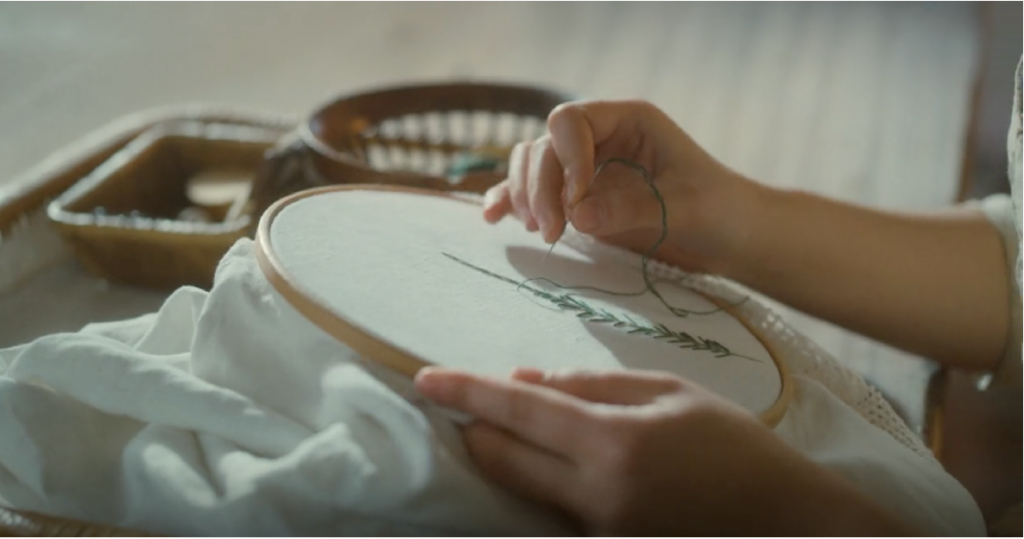
It is from these accumulated layers of meaning that the viewer can fully appreciate the brilliance that is in the beach scene. As the two women embrace, the ocean brings in the color blue, making the scene reflect the use of the classic triadic colors: red, green, and blue. Though these three colors work together as triadic colors, the blue backdrop and all of the meaning that the viewer has started to understand associated with the use of blue serves to deliver the most heartbreaking message: these two women have finally found their connection and love, but the repressiveness of society will never allow them to be together. In terms of lighting, the diegetic lighting of the beach scene is bright all around, implying the joy of the couple and contrasting against the sorrow that is to come. The use of color throughout the film building up to the beach scene serves narratively to guide the viewer through a journey of growth and passion while conveying the gut-wrenching reality of the times. The beach scene is a culmination of desire and bleakness, hope and despair.
In closing, I turn to the last key scene in my study of this film, which takes place when when Héloïse stands at the top of the stairs in her wedding dress, watching as Marianne leaves the house forever. The white of the wedding dress is classic, in line with the traditional expectations for a wedding gown. And yet, the white color of the dress signifies so much more than a wedding. The white color, at once hopeful and pure, also bears a more haunting and horrific connotation. When Marianne and Héloïse consummate their relationship for the first time, a long shot reveals them sleeping in bed with the scene displaying an almost monochromatic white color scheme. The entire bed, sheets, pillows, and even bed frame are varying shades of white, with the two women perfectly encased within them together. The light that flows through the window lights up the scene and makes their skin flawless, almost as if they were characters stepping out of a painting. The whiteness that surrounds them, as well as the lighting, are conscious choices by Sciamma to symbolize the purity and hope that the two have cultivated together. In that moment, nothing can blemish the pureness of their love for each other.
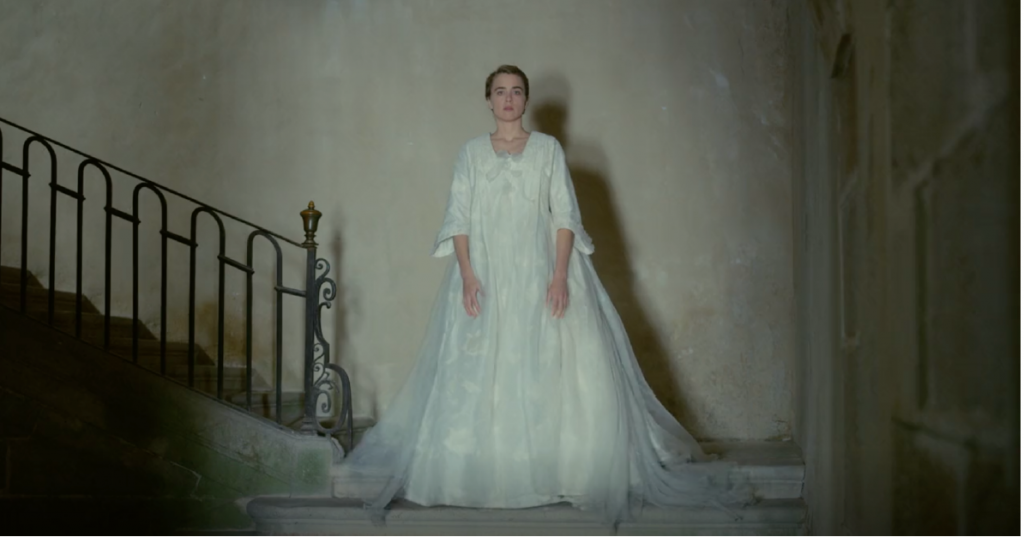
The color white is also, of course, heavily associated with the blank canvases upon which Marianne paints. In fact, the opening shot of the film is a close-up of a blank canvas upon which one of Marianne’s students begins to paint. The whiteness of the canvas is an entirely blank surface, ready to be painted on, just as the love of Marianne and Héloïse is a pure love, ready to be created.
However, the color white also shows up when Marianne begins to see visions of Héloïse in a white wedding dress, looking like a phantom or a vision. This eeriness actually brings a more haunting quality to the use of white, as it reminds the viewer that white is not all light and pureness; it can also be associated with horror and pain that can destroy instead of build. With the color white, the viewer is reminded of the pure, unadulterated happiness of the two in their lightest moments but also the haunting visions of Héloïse that Marianne experiences in the dark. Yes, love can be a pure and joyful treasure, a lovely canvas upon which it can be painted, but it can also be a haunting concept, full of ache and pain. These meanings culminate in the scene of Héloïse in the wedding dress at the end of the film. When this moment occurs, the viewer can finally tie together all of the meaning that the white brings with it, and understand that ultimately, Marianne makes the “poet’s choice” that she ponders earlier on in the film after hearing the myth of Eurydice and Orpheus: she yields to the conditions around her and chooses the memory of her lover instead of her actual lover. With all of the symbolism and meaning that the use of color and light provides comes the roar of reality: their love has to withstand the unfortunate test of the oppressiveness on women in the times.

Portrait of a Lady on Fire is a true masterpiece of color and light. All of these design choices are significant in highlighting symbolic meanings within the film, which aggregate and then allow the viewer to understand and appreciate key scenes in the film. Sciamma’s film carefully blends the lines of symbolism and realism; its use of color and lighting help the viewer find themselves at the intersection of the two. With color and lighting, the viewer is able to simultaneously enjoy the hidden depth and meaning of the scenes while understanding the harsh reality of the woman’s experience in society. It is a true treasure of a film that will have viewers mesmerized for years to come.
